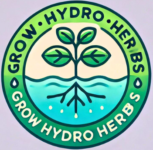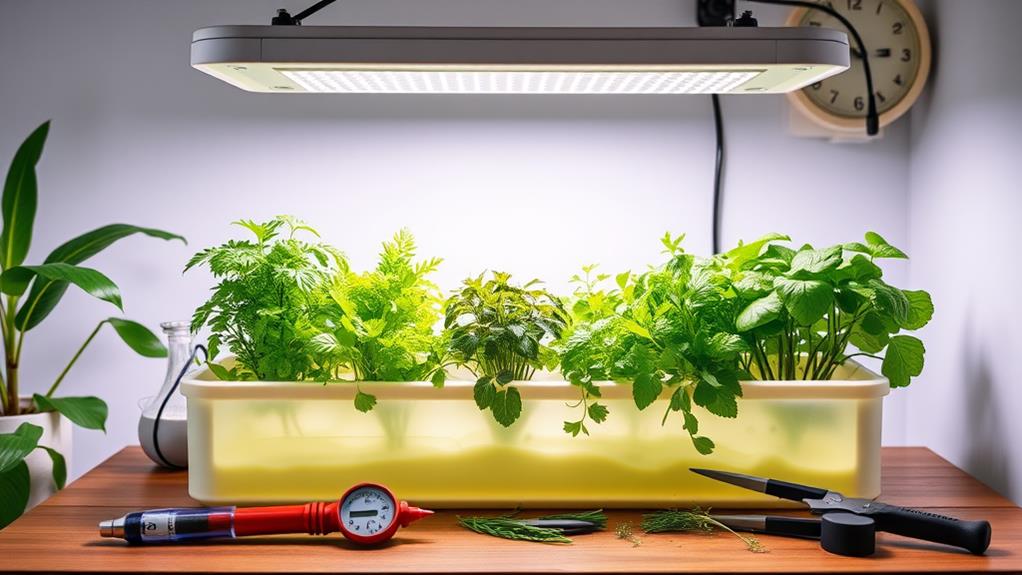The Benefits of Growing Herbs Indoors with Hydroponics
Hydroponics is a method of growing plants without soil, using nutrient-rich water instead. When combined with indoor gardening, it offers a controlled environment, free from many of the challenges associated with traditional gardening. This means you can grow herbs year-round, regardless of the weather outside. But you need to know how to start herb seeds indoors.
One major advantage of growing herbs indoors with hydroponics is the ability to control every element of the growing environment. You can adjust light, temperature, humidity, and nutrient levels to suit the specific needs of your plants. This level of control often results in higher yields and healthier plants compared to traditional soil gardening.
Another benefit is convenience. Having fresh herbs readily available in your kitchen can significantly enhance your cooking. Basil, mint, and oregano picked just moments before use can elevate the flavor of any dish. Plus, with a hydroponic setup, there’s less mess without soil to deal with, making it a cleaner option for indoor gardening.
The health benefits are also noteworthy. Freshly grown herbs can provide more nutrients compared to store-bought options. They’re free from pesticides and other chemicals often used in commercial farming. Growing your own herbs hydroponically allows you to have full control over what goes into your plants, ensuring they’re as healthy as possible.
In summary, indoor hydroponic gardening offers numerous benefits, including year-round growth, environmental control, convenience, and health advantages. It’s a rewarding hobby that can lead to a more sustainable and healthy lifestyle.
GrowHydroHerbs TLDR
- Growing herbs hydroponically indoors allows year-round cultivation with complete environmental control over light, temperature, and nutrients
- Essential starting equipment includes seed trays, grow lights (LED or fluorescent), nutrient solutions, and appropriate growing medium like rockwool or coconut coir
- Most herbs thrive in temperatures between 70-75°F with 50-70% humidity and 14-16 hours of daily light exposure
- Fast-growing herbs like basil, mint, and oregano are ideal for hydroponic beginners due to their adaptability and quick results
What You’ll Need to Start Herb Seeds Indoors for Hydroponics
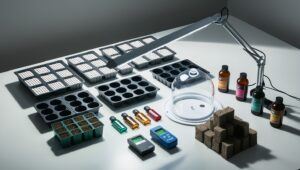
Embarking on your hydroponic gardening journey requires a few key pieces of equipment. Essential items include seed trays, grow lights, and nutrient solutions. Starting with the right gear sets the foundation for successful germination and growth.
First things first, seed trays are crucial for germinating your herb seeds. They provide the initial space for seeds to sprout before they are moved to your hydroponic system. Choose trays that offer good drainage, as excess water can lead to mold and other issues.
Next up, lighting. Proper grow lights are non-negotiable for indoor gardening. While natural sunlight is great, it’s often insufficient for indoor spaces. LED and fluorescent grow lights are reliable options, each with its pros and cons. LEDs are energy-efficient and offer a customizable spectrum, while fluorescents are budget-friendly and effective for smaller setups.
Nutrient solutions are another major component. Instead of soil, hydroponic systems use water enriched with essential nutrients. Look for nutrient solutions designed specifically for seedlings. They contain the right balance of minerals to encourage strong, healthy starts.
Choosing quality seeds is equally important. Opt for seeds from reputable suppliers to increase your chances of successful germination. Poor-quality seeds can lead to uneven growth and disappointments down the line.
The grow medium supports the seeds as they germinate. Options include rockwool, coconut coir, and peat pellets. Each has unique properties, so pick one that fits your system’s needs and your personal preferences.
Lastly, maintaining the right temperature and humidity is key. Seedlings thrive in stable conditions, usually around 70-75°F and 50-70% humidity. Consider using a thermostat and a humidity monitor to keep things in check.
Step-by-Step Guide to Start Herb Seeds Indoors
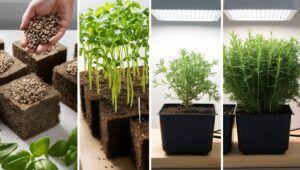
Select the Growth Medium – Selecting a grow medium is critical when starting herb seeds indoors. Common choices include rockwool cubes, coconut coir, and peat pellets. Each offers distinct advantages, such as excellent moisture retention (rockwool) or being eco-friendly (coconut coir). Make sure the medium you choose supports root development and fits well with your hydroponic setup.
Maintain Temperature and Humidity – Temperature and humidity play significant roles in seed germination. Seeds typically germinate best between 70-75°F and in humidity levels around 50-70%. Using heat mats and humidity domes can help maintain these conditions. Keep a consistent environment to encourage strong, even growth.
Know Each Herb – Not all herbs are equal when it comes to hydroponic gardening. Basil, mint, and oregano are excellent choices, known for their robustness and adaptability. These herbs not only germinate quickly but are also forgiving if conditions aren’t perfect. Research the needs of each herb type before planting to ensure you can provide the appropriate care.
Planting Process – The process of planting seeds is straightforward but requires attention to detail. First, soak your grow medium in water until fully hydrated. Place the seeds on or in the medium, following guidelines on seed depth – usually around 1/4 inch. Lightly cover the seeds if needed. Put your tray in a warm, dimly lit area until sprouting begins.
Keep Medium Moist – During the germination phase, keep the grow medium moist but not waterlogged. Check daily to ensure the medium doesn’t dry out. Once seedlings appear, move the trays under grow lights, gradually increasing light exposure. This transition helps prepare the young plants for the more intense light levels they’ll experience in the hydroponic system.
Best Grow Lights to Start Herb Seeds Indoors
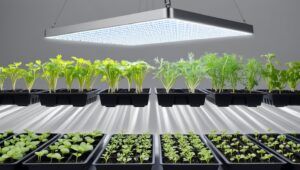
Choosing the right grow lights is a crucial step in setting up your indoor hydroponic garden. Your plants rely on these lights to mimic natural sunlight, providing the energy needed for photosynthesis and growth. LEDs and fluorescent lights are the most common options, each with benefits and drawbacks.
LED grow lights are popular for their energy efficiency and long lifespan. They offer a customizable light spectrum that can be adjusted to meet the specific needs of your herb seedlings. Though they have a higher upfront cost, their energy savings and durability often justify the investment. LEDs also produce less heat, reducing the risk of burning young plants.
Fluorescent grow lights are another reliable option, particularly for those on a budget. They’re effective for smaller setups and provide ample light for germination and early plant growth. However, they usually have a shorter lifespan and consume more energy compared to LEDs. T5 fluorescent tubes are a specific type often recommended for seedlings due to their balanced light spectrum and affordability.
Optimizing your light schedule is key to successful germination. Herb seedlings typically require 14-16 hours of light per day. Ensuring your lights are on a timer can help maintain a consistent light schedule, promoting healthy growth. Place the lights a few inches above the seedlings and adjust as they grow to maintain the right distance, usually around 2-3 inches for most seedlings.
Different herbs might have varying light needs, so observe your plants and adjust accordingly. Start with the recommended settings but be ready to tweak based on the specific behavior of your herbs. Wilting or leggy seedlings often indicate insufficient light, while scorched leaves can mean the lights are too close or on for too long.
Understanding Nutrients for Seedlings in Hydroponics
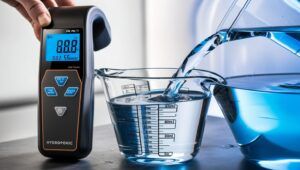
Nutrient solutions serve as the lifeblood of your hydroponic system. Instead of drawing nutrients from soil, your herb seedlings rely entirely on these solutions to get the minerals they need for growth. Starting with the right nutrient solution designed for seedlings ensures they get the precise balance of nutrients to thrive.
Balancing nutrient levels is crucial. Seedlings are delicate and can be sensitive to nutrient imbalances. Most commercial nutrient solutions provide detailed instructions on how to mix and use them. Following these guidelines helps avoid problems like nutrient burn or deficiencies, which can stunt growth or even kill your plants.
pH levels also play a significant role. The ideal pH range for hydroponic herb seedlings is typically between 5.5 to 6.5. Regularly check and adjust your pH using a digital pH meter and pH adjustment solutions. Maintaining proper pH levels ensures that your seedlings can absorb the nutrients effectively.
Overfeeding is a common mistake when starting out. Using more nutrients than recommended won’t speed up growth and can harm your seedlings. Stick to the recommended dosages and monitor your plants closely. If you notice signs of nutrient burn, such as yellowing or browning of leaf edges, it may be a sign to dilute your solution.
Consider using organic nutrient solutions, especially if you prefer a more natural approach. Organic solutions can be less concentrated, reducing the risk of nutrient burn. However, they might require more frequent adjustments compared to synthetic solutions. Choose the option that best aligns with your gardening goals and maintenance preferences.
In essence, understanding and managing the nutrient needs of your seedlings is vital for a healthy hydroponic garden. Consistent monitoring and adjustments, when needed, will set the foundation for thriving, robust herb plants.
Managing Seedling Growth for Hydroponic Systems
Transplanting seedlings from seed trays to your hydroponic system is a crucial step. Wait until seedlings have at least two sets of true leaves before moving them. Handle seedlings gently to avoid damaging their delicate roots. Use a well-aerated grow medium in your hydroponic system to support root development.
Pruning is essential for healthy growth. Start by trimming any weak or leggy growth. This encourages the plant to focus energy on developing stronger, more productive branches. Regular pruning also prevents overcrowding, which can lead to problems like mold and poor air circulation.
Early-stage care involves close monitoring of your plants’ environment. Check your nutrient solution regularly to ensure it’s at the right concentration and pH. Maintain consistent light schedules and avoid drastic temperature changes. Use fans to improve air circulation, reducing the risk of mold and pests.
Monitoring growth conditions is key. Keep an eye out for signs of stress or poor health, such as yellowing leaves or stunted growth. Adjust nutrient levels, lighting, and other environmental conditions as needed. Regularly inspect your plants to catch any issues early before they worsen.
Managing seedling growth effectively sets a solid foundation for a thriving hydroponic herb garden. With careful attention and timely interventions, your seedlings will grow into robust, productive plants.
Common Issues When Starting Herb Seeds Indoors
Starting herb seeds indoors can present several challenges, but being aware of common issues can help you manage them effectively.
Slow germination is a frequent problem, often caused by incorrect temperature or inadequate moisture. Ensure conditions are stable, with temperatures between 70-75°F and consistent humidity. Using a heat mat and humidity dome can help maintain optimal conditions.
Mold and root rot are other common issues. These problems usually stem from excessive moisture and poor air circulation. Prevent these by ensuring proper drainage in your seed trays and using fans to promote airflow. Avoid overwatering by keeping the grow medium moist but not soggy.
Pests can also be problematic indoors. Common invaders include aphids, spider mites, and fungus gnats. Inspect your plants regularly to catch infestations early. Employ natural remedies like neem oil sprays and insecticidal soap if necessary. Good hygiene practices, like cleaning tools and trays, can also minimize pest problems.
Leggy seedlings are often a result of insufficient light. If your seedlings are tall and spindly, consider adjusting your light setup. Position grow lights closer to the seedlings, about 2-3 inches above, and ensure they receive 14-16 hours of light daily. This encourages sturdy, compact growth.
Lastly, nutrient imbalances can cause various issues, from leaf discoloration to stunted growth. Regularly monitor and adjust the nutrient solution and pH levels. Stick to recommended dosages and schedules to avoid overfeeding, which can be just as harmful as underfeeding.
Best Choices to Start Herb Seeds Indoors for Hydroponic Gardens
Basil, with its fast growth and versatility, is a fantastic option for indoor hydroponic gardens. Its strong aromatic leaves are perfect for a variety of culinary applications, from pasta to pesto. Basil germinates quickly and thrives in hydroponic systems, making it a favorite among beginners and seasoned gardeners alike.
Mint is another excellent choice. This resilient herb is known for its rapid growth and refreshing flavor. Ideal for teas and garnishing, mint can grow prolifically in hydroponics. Regular pruning is essential to keep it from overtaking your garden.
Oregano, with its robust flavor and adaptability, is well-suited for hydroponic growing. It’s perfect for Italian dishes and pairs well with other herbs. Oregano is hardy and can tolerate varying conditions, making it a reliable choice for your indoor setup.
Cilantro is worth considering if you enjoy its distinctive taste. Although it can be challenging due to its sensitivity to temperature changes, cilantro can grow successfully with careful monitoring. Its fresh leaves are excellent for salsas and garnishes.
Chives are perfect for hydroponic systems, offering a mild onion-like flavor that complements many dishes. They’re relatively easy to grow and require minimal maintenance, making them a great addition to your herb garden.
Thyme is another reliable herb for hydroponic gardens. Known for its tiny, fragrant leaves, thyme is a staple in many culinary recipes. It’s a hardy herb that can thrive even with less-than-ideal conditions, making it a practical choice for beginners.
Choosing herbs that grow quickly and adapt well to hydroponic conditions ensures a bountiful and diverse indoor garden. Experiment with different herbs to find the ones that best suit your tastes and growing environment. Each has unique culinary uses and growth requirements, adding both flavor and variety to your homegrown offerings.
Questions? We Have Answers.
Get answers to a list of the most Frequently Asked Questions.
